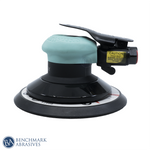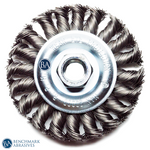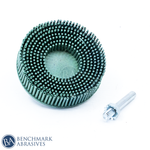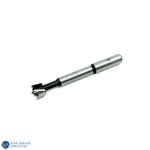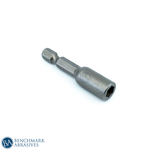
A Guide To Cloth Backed Abrasives

Achieve greater control over every finish, reduce replacement costs, and increase production with a deeper understanding of cloth-backed abrasives. This guide covers everything you need to know about fabric backings—their uses, advantages, varieties, and how to choose the best one for your project.
COATED ABRASIVES
Let's start by discussing coated abrasives since they are the abrasives that have fabric backings.
Coated abrasives are products for sanding and grinding created by sticking abrasive grains to surfaces such as paper, fabric, etc. The grain is used to "coat" the abrasive.
The method used to connect the abrasive grains to the coating can vary depending on the product. It can include resin bonding, electrostatic coating, or adhesives like glue.
- RESIN BONDING: Several resin layers may be used for improved strength and grain retention. Resin-bonded abrasives are more resilient to moisture and heat.
- ELECTROSTATIC COATING: Using an electrostatic field, this technique places the abrasive grains on the backing. It ensures that the grains are distributed exceptionally uniformly.
- GLUE BONDING: This is an older technique in which the abrasive grains are attached to the backing using glue or another adhesive coating.
- MECHANICAL BONDING: The abrasive grains are interlocked with a roughened or textured backing surface.
CLOTH BACKING: WHAT IS IT?
When you browse for coated abrasive tools, such as flap discs and sanding belts, you'll frequently notice that they have cloth backing. Different abrasive products have different backings, and the kind of backing has a significant impact on the performance of that specific abrasive product.
The abrasive grains are linked to the abrasive backing. For instance, abrasive grains are pasted onto a paper backing in conventional sandpaper sheets with the word "paper" in their name. Nowadays, abrasive products come with several backing options, such as cloth.
VARIOUS CLOTH TYPES
The performance of your abrasive is directly impacted by the type of cloth backing you use. The support is crucial to achieving the intended outcomes quickly and successfully, from the product's lifespan to its suitability for particular jobs.
The purpose of the abrasive product should guide your choice of cloth material:
- COTTON: Cotton backing is well-known for its suppleness, making it perfect for intricate and contour work.
- POLYESTER: Because of its strength, it can be used for more complex, more demanding tasks.
- BLENDS OF POLY-COTTON: These are useful for various applications because they strike a nice mix of strength and flexibility.
BACKING WEIGHT
The "backing weight" is another specification for abrasives with cloth backing. The density and thickness of the fabric used as the backing are referred to as the "weight" of the material. The weight of the fabric backing determines the abrasive's strength, flexibility, and appropriate uses.
The letters J, X, Y, and others are typical industry labels representing various backing material weights and properties. What each letter stands for is as follows:
-
J-WEIGHT
Meaning: 'J,' often known as jeans, is a remarkably flexible and light cloth backing.
Features: J-weight fabric usually comprises a softer, more malleable material, such as cotton. Because of its extreme flexibility, it may be rolled or folded without breaking or ripping.
Uses: It is perfect for fine woodworking, elaborate metalwork, or any application where the abrasive must follow complex curves and contours.
- X-WEIGHT
Meaning: 'X' is a medium-weight and more robust textile backing, frequently called drill.
Features: It provides a nice mix of strength and flexibility, making it more durable than J-weight clothing. X-weight clothing is typically composed of more resilient materials that can withstand more strain, such as blends or more robust polyester.
Uses: This material is appropriate for general-purpose sanding activities. It is usually used to create various abrasive products for home and commercial use. An x-weight backing is typically seen on high-quality flap discs and sanding belts.
-
Y-WEIGHT
Meaning: 'Y' denotes a robust and substantial fabric backing.
Features: It is the strongest and thickest, offering superior sturdiness and tearing resistance. Y-weight backings are less flexible than J or X-weights and are usually composed of sturdy materials.
Uses: Frequently employed in demanding industrial settings, such as metal manufacturing, where intense pressure and forceful material removal are required.
THE ADVANTAGES OF CLOTH BACKING
The following advantages of cloth backing for abrasive items improve their performance:
- DURABILITY AND LONGEVITY: Even under harsh circumstances, cloth-backed abrasives are renowned for their resilience and long life.
- FLEXIBILITY: They adapt readily to various surfaces and forms, making them useful for multiple jobs.
- STRENGTH: Because fabric backing is so durable, you can use it for more vigorous sanding or grinding without worrying about ripping.
- CONSISTENCY: Abrasive grains can wear down more uniformly due to their strong adherence, which promotes consistent abrasion and a uniform finish over time.
- ADAPTABILITY TO A VARIETY OF USES: Cloth-backed abrasives can be used for various activities, from fine polishing to heavy-duty grinding.
- CONSISTENCY: Abrasive grains can wear down more uniformly due to their strong adherence, which promotes consistent abrasion and a uniform finish over time.
- ADAPTABILITY TO A VARIETY OF USES: Cloth-backed abrasives can be used for various activities, from fine polishing to heavy-duty grinding.
DIFFERENT BACKING TYPES VS. CLOTH
We won't declare cloth backing "better" than other types because every abrasive has a particular purpose. Understanding the many abrasive backing kinds can help you select the best one for the task.
PAPER VS. CLOTH BACKING
- PAPER BACKING: This material is usually used for delicate finishing and lighter work. It is more flexible than cloth, enabling a smoother finish on delicate surfaces. However, it can rip easily and is less intense when used heavily.
- CLOTH BACKING: It is more suitable for demanding jobs and situations requiring an abrasive that can tolerate increased pressure or repeated application. Although less flexible than paper, it is more resilient to tearing.
FILM BACKING VS. CLOTH
- FILM BACKING: Film backings are frequently utilized in industries like electronics and automobiles that demand ultra-fine finishing. Although they cost more than cloth, film backings offer a more consistent finish. Wet sanding is another everyday use for film-backed sanding discs, producing less dust.
-
CLOTH BACKING: It is more appropriate for fundamental to heavy-duty jobs where longevity and durability are important considerations. It can finish, but the film offers a better option for excellent finishes.
FOAM VS. CLOTH BACKING
- FOAM BACKING: This backing is perfect for flexible, padded backing for contour sanding applications. It has an excellent finish but is less durable than cloth for heavy applications.
- CLOTH BACKING: Cloth is better suited for rough grinding or sanding. While foam may provide greater flexibility in form, cloth offers a combination of strength and adaptability that foam cannot match in more demanding situations.
CLOTH VS. MESH BACKING
- MESH BACKING: Known for its ability to extract dust, mesh backing lessens loading and clogging and makes the workspace cleaner. However, it might provide a different degree of durability than cloth.
- CLOTH BACKING: Although the cloth could be better at extracting dust, it is dependable for heavier jobs because of its exceptional durability and strength.
UTILIZING CLOTH-BACKED ABRASIVES - APPLICATIONS
Abrasive materials backed by cloth are very adaptable and find application in a wide range of sectors. Here are a few typical applications where they excel:
- METALWORKING: Used for metal surface finishing, deburring, and grinding. Welders' and metalworkers' heat and pressure are withstanding by cloth backing.
- WOODWORKING: Cloth is perfect for smoothing and shaping wood, particularly for carpentry and furniture construction. Unlike firmer backings, the cloth's suppleness allows it to better conform to curves and features.
- AUTOMOTIVE: Cloth is widely used for surface preparation and finishing in auto body work. Its resilience comes in handy when mixing metal and working on huge areas.
- CONSTRUCTION: This tool is used in various construction projects for tasks such as smoothing and shaping concrete, wood, and metal, as well as cleaning and preparing surfaces for painting, finishing, and repairs.
- BLADESMITHING: Bladesmiths require additional control and durability to achieve a razor-sharp finish, so cloth-backed sanding belts are indispensable equipment for DIY knife production.
- DIY PROJECTS: Home renovation projects are a favorite of DIY enthusiasts because of their versatility and durability.
A GUIDE TO CHOOSING CLOTH-BACKED ABRASIVES
Selecting the appropriate cloth-backed abrasive is essential to attaining optimal outcomes. Consider the following:
- WORK-BASED
The kind of abrasive you require will always depend on your particular project. Use Y-weight or other more robust backings for hard grinding. A J-weight backing would be better appropriate for finer, more detailed work. Always confirm with the manufacturer that the cloth is OK for wet sanding before using it.
- THE MATERIAL
Different abrasives are needed for other materials. Make decisions based on considering the content you will be working on. For best results, match the type of abrasive grain (silicon carbide or aluminum oxide) with the fabric backing.
- TYPE OF BOND
Think about whether a closed or an open coat is better. Open coats help lower loading, while closed coatings can maximize cutting speed.
- HARMONY
Select an abrasive appropriate for your tools' dimensions, thickness, arbor hole size, maximum RPM, and mounting style (hook & loop, PSA, etc.).
MAINTENANCE AND SAFETY
Like any other abrasive product, cloth-backed abrasives require proper maintenance and safety procedures. Here's how to guarantee durability and secure use:
- STORAGE: Keep them out of direct sunlight and in a cool, dry environment to avoid moisture damage and warping.
- INSPECTION: To prevent mishaps, routinely inspect for tears or dangerous wear before using.
- SAFETY GEAR: When using these or any other abrasives, always use the proper safety gear, such as gloves, eye protection, and a mask.
- QUALITY IS IMPORTANT: Purchasing premium abrasives from reliable vendors like Benchmark Abrasives guarantees improved performance and increases safety.
Remember that maintaining your tools is as essential as selecting the appropriate ones.
CONCLUSION
Choosing the appropriate tool for your project requires understanding the qualities and properties of cloth backings in abrasive tools. Because of their robustness, adaptability, and reliable operation, abrasives are essential in many industrial and do-it-yourself applications. Benchmark Abrasives is dedicated to offering trustworthy, high-quality abrasives so you can accomplish the finest possible results in your work.












